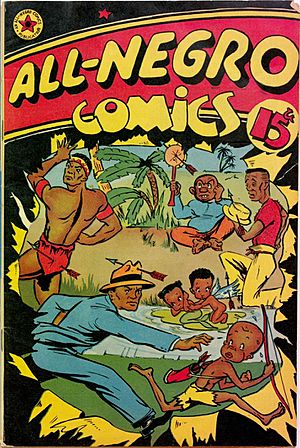African characters in comics facts for kids
Characters from the African continent have appeared in comics since the very beginning of modern comic strips. At first, in the early 1900s, comics often showed African characters in a stereotypical and sometimes unfair way. They were sometimes drawn as spear-carrying "cannibals" or "noble savages". Over time, how African characters were shown changed. They started to appear as regular, well-rounded human beings, just like any other character.
Contents
History of African Characters in Comics
American Comics
In the early days of American comics, many characters from different backgrounds were shown using funny but often unfair stereotypes. Black people were sometimes drawn in ways that made them seem foolish or cowardly. Even in serious comics, up until the 1950s, Black characters were sometimes drawn with exaggerated features.
One of the first important Black characters in comics was Lothar from the adventure comic strip Mandrake the Magician. He first appeared in 1934. Lothar was a prince from jungle tribes. He chose to travel the world with Mandrake, fighting crime instead of becoming king. He was known as the strongest man in the world. At first, he was shown as someone who didn't read or write and wore animal skins. But in 1965, he was updated to wear suits and speak standard English.
In 1947, a company called All-Negro Comics, Inc. published a special comic book called All-Negro Comics. It had different stories and characters, including Lion Man. Lion Man was a young African scientist. The United Nations sent him to the African Gold Coast to look after a huge uranium deposit. He fought against a villain named Doctor Blut Sangro.
It wasn't until Waku, Prince of the Bantu appeared in Jungle Tales in the 1950s that mainstream comics showed an African character as a strong, independent hero. Waku was an African chieftain, and his stories didn't usually feature any white characters.
The first known Black superhero in mainstream American comic books was the Black Panther from Marvel Comics. He is an African character who first appeared in Fantastic Four #52 in July 1966. After him came the first African-American superhero, the Falcon, who appeared in Captain America #117 in September 1969. DC Comics' first African-American superhero was Sgt. Willie Walker, also known as Black Racer, who appeared in New Gods #3 in July 1971. Marvel's first major African female character was the superhero Storm.
African Comics
The comic series Powerman was created in 1975 in London, England. It was meant to be an educational tool and was given out in Nigeria. Powerman was super-strong and could fly. His only weakness was snakebite.
Jet Jungle and his black panther, Jupiter, were popular in South Africa. They starred in a long-running radio play and comic strip from 1965 to 1985. Jet Jungle was seen as a forward-thinking character for his time. He inspired many children to care about nature and the environment.
In 2005, Nelson Mandela, a famous leader from South Africa, announced a comic book series about his early life. It was called A Son of the Eastern Cape. This graphic novel had 8 volumes and was translated into South Africa's 10 other official languages.
Umlando Wezithombes is a company that creates African comic books. They have covered many important topics like Steve Biko, water conservation, and gay and lesbian rights.
Belgian Comics
In 1930, Hergé drew Tintin in the Congo, where his character Tintin visits the Belgian Congo. At that time, Africa was often shown in a very stereotypical way, with all Black people living in tribes and seeming simple or lazy. Hergé later said he didn't do much research back then and that the book showed how many Europeans thought about Africa.
In 1939, Jijé created Blondin et Cirage, which featured a young white boy, Blondin, and his Black African friend, Cirage. Unlike many comics of that time, Cirage was shown as being just as smart as his white friend. The Lucky Luke series by Morris also features many Afro-Americans. They are never shown as slaves, but as polite and helpful housekeepers and servants.
Dutch Comics
In 1947, a Black African child named Sjimmie was teamed up with the character Sjors in the Dutch comic series Sjors en Sjimmie. Sjimmie at first spoke in broken Dutch. But in 1969, the character was redesigned, and all the stereotypical elements were removed.
Italian Comics
One of the earliest Italian comic strips was about a little African boy named Bilbolbul. This comic was drawn between 1908 and 1933 by Attilio Mussino.
See Also
- List of black animated characters
- List of black superheroes
- Portrayal of black people in comic books
- Ethnic stereotypes in comics
- Stereotypes of African Americans


